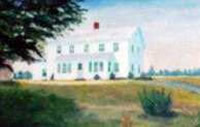The Beehive House
Home of Pioneer
Thomas and Phebe Hartt
and 50 other families for 189 years

The house as it was |

The house in modern times before it was torn down |
(Pioneer
Thomas, Thomas A, Jonathan, Samuel, Isaac)
Thomas and Phebe (Phillips) Hartt arrived from Gagetown, N.B.
to Wabi Goub Skw meaning "The White Run" or "Silver
Springs" in 1804. Thomas bought 900 acres from Ambrose
Sherman, the governor of Nova Scotia. The deed was signed April
16, 1804. Included in this acreage was land on both sides of
the North West Branch of the Oromocto River at a small falls.
These falls proved to be a suitable site for the milldam.
Soon
after arriving, he built a log cabin on this land near the river,
which was the main route of transportation. Shortly after he
started a sawmill and a gristmill on the North Branch of the
Oromocto River. These mills were situated on each end of the
dam and were in operation by 1810. This place was known as Hartt's
Mills. Later, when the railway came through this area in 1869,
the name changed to Fredericton Junction, N.B.
In 1815,
Thomas built a large house in front of his original log cabin.
It was the first house in the settlement with sawn lumber used
in the construction. It got the name "Beehive" because
people were always coming and going and it was always busy like
a bee's hive. The Beehive was on the road from St. Andrews to
present day Fredericton and served as a stop over for the stagecoach
and other travelers.
The house
was built from the lumber that Thomas hand made. There was a
total of twelve rooms and an attic, which was used by travelers
in early years for a place to sleep. Downstairs there were seven
rooms and five rooms were upstairs, with nine bedrooms total.
To get up stairs there were two stairways, one from the kitchen
and the other from the hall in the other end of the house.
The
chimney, which was very large, was built in the small dug out
dirt cellar. This chimney was large enough to accommodate fireplaces
in almost every room downstairs and up. The ceilings in the
house were quite low. Later this chimney was taken down and
four wood stoves were used to heat the house.
The first
kitchen was also made over and a veranda built on the front.
At the same time the hallway going through the house was blocked,
so two families could live in the house. One of the sitting
rooms then was converted to a kitchen. More than 50 families
have lived in this house. The house was supplied with water
hauled from a spring on the property.
Twenty
five years ago, most if not all of the woodwork in the house
was the original wood Thomas had laid down in 1813 but there
were only a few of the first windows and window frames left.
These windows have small panes of glass and were in the back
of the house only. Besides having the forest near by the house
had at one time great lilac bushes, cranberry bushes and also
a few cherry trees.
Considerable
acreage surrounding the homestead was cleared, barns and outbuildings
were erected, stock was acquired and soon the Hartt farm because
a prosperous one. There were many barns on the property to house
the horses of travelers and the stagecoach, which stopped over.
These barns were burned down once in a fire that started in
a small sawmill, which was on one of the three springs that
ran through the Hartt property.
In the
Miramichi Fire of 1825 the Beehive was one of the few houses
to escape destruction due to the earnest prayers of Phebe Hartt.
During the fire the people went down to Hartt's dam and stayed
there until a bit of luck came their way and the wind changed.
The fire stopped within a quarter mile of the Beehive.
Thomas
and Phebe had a large family, eight daughters and three sons.
As each grew older and married, their father Thomas would give
each one some land and help them build a home. While Thomas
and his sons were farming, lumbering and running the mills,
his daughters taught school in different houses in the community
until the first school was built in 1862 which was called Mount
Bleak Academy. Thomas's children married local people of the
area. The lumbering and milling business flourished so that
by October 13, 1851, when Thomas Hartt's will was drawn, he
owned a considerable estate. As beneficiaries he named his wife
and each of his eleven children, dividing his possessions in
varying amounts among them. (You can read his will in "Hart
to Hartt" book page 266)
Included
in the real estate were two lots at the mouth of the Yoho Stream,
a lot at Hardwood Creek, six lots all on the Upper river, the
grist mill, the sawmill and the homestead farm. The total consisted
of several thousand
acres.
The first
time the Beehive had not been owned by a member of the Hartt
family was in 1974 when a great- great grandson, Harold Nason,
sold it to Mr. Seabrooks from Newfoundland, Canada. The house
was torn down in 2003 and the fire department burned the lumber
that was left for fire practice.
In the
early days, the community had, besides a sawmill, gristmill,
and a stop over for the stagecoach, a blacksmith shop, tanneries,
pubs, shipyards, and even the Oromocto Coal Company. The first
post office and general store was built in 1813. The store got
its supplies by ship from Oromocto, Saint John landings and
the Prides Landing about one and a half miles away.
Information gleaned from the essay of Alice (Duplisea) Deschenes
and "Days of Old"